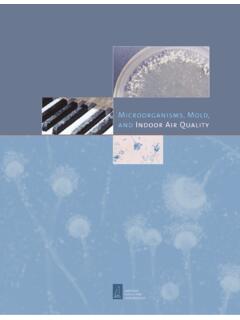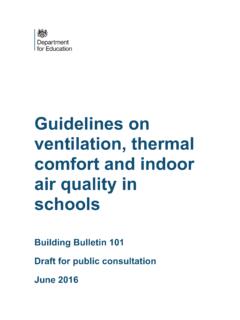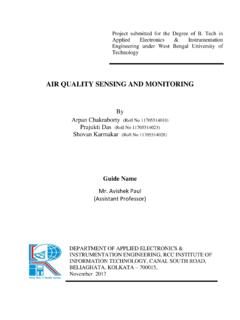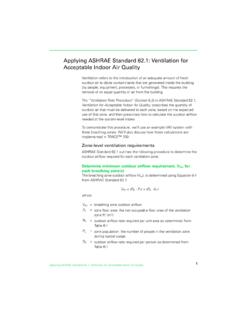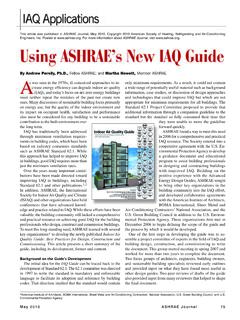Transcription of Indoor Environmental Quality Standard Second version: 2018 ...
1 1 1 ISHRAE Indoor Environmental Quality Standard Second version: 2018-2019 2 3 4 5 6 7 8 9 10 11 12 13 14 15 2 16 Index 17 Clause no. Clause Page no. Foreword 3 Introduction 4 5 1 Scope 6 2 Normative reference 7 9 3 Terms and definitions 10 15 4 Classification 16 5 Abbreviations, symbols and units 17 18 6 Indoor Environment Quality elements Tests and Testing methods 19 - 42 7 Occupant satisfaction survey 43 - 45 8 Document methodology 46 - 48 Annexure A (informative) Thermal comfort 49 51 Annexure B (informative) Indoor air Quality 52 60 Annexure C (informative) Visual comfort 61 63 Annexure D (normative)
2 Recommended methodology to calculate Equivalent Melanopic Lux (EML) for different type of lighting conditions 64 66 Annexure E (normative) Recommended methodology to calculate lighting comfort parameters 67 Annexure F (informative) Acoustic comfort 18 19 20 21 22 23 24 25 26 3 Foreword 27 28 29 30 31 32 33 34 35 36 37 38 39 40 41 42 43 44 4 Introduction 45 Indoor Environmental Quality (IEQ) refers to the Environmental conditions inside regularly occupied space 46 that is determined by many factors, including Indoor air Quality (IAQ), thermal comfort, visual comfort, 47 acoustic comfort as well as ergonomics.
3 IEQ has an impact on health, comfort, and safety, which in turn 48 affects productivity of occupants. 49 Research has shown that poor IEQ can have short and long term health effects. Indoor air pollutants can 50 lead to health disorders such as headaches, allergies, asthma, and other respiratory diseases. Furthermore, 51 conditions such as temperature, relative humidity, noise and lighting levels outside the acceptable comfort 52 ranges could increase the stress level in human body, thus creating health issues like sleep disorder, 53 digestive problems, and memory and concentration impairment besides resulting into discomfort of 54 occupant.
4 55 In a good Indoor environment, work efficiency of occupants gets enhanced, learning results are better 56 among students and absenteeism is lower. This in-turn increases workplace productivity and test scores in 57 schools, which is supported by research. 58 59 60 This Standard identifies thermal comfort, Indoor air Quality , comfort and acoustic comfort as four critical 61 elements of IEQ. Each of these elements have been covered by defining their threshold levels of IEQ 62 parameters. Three levels for defining threshold values have been created: Class A (Aspirational), Class B 63 (Acceptable) and Class C (Marginally acceptable).
5 The defined threshold levels become more stringent for 64 Class B and Class A. Some parameters have been omitted in Class B and Class C as the Standard is 65 applicable to variety of buildings ranging from unconditioned residences to large air conditioned commercial 66 complexes. Class A is comparable with international standards. 67 This Standard is designed in such a way that an IEQ rating system can be evolved. Any building evaluated 68 using this Standard , can be assessed as Class A, Class B, and Class C while complying with any individual 69 parameter.
6 It is possible that for one parameter; example IAQ, a building may perform better than Class A, 70 whereas, for some other, it might not even meet threshold level as Class C. 71 5 There are several other IEQ elements and parameters that could have been included in this Standard . 72 However, wherever reliable supporting data, published studies, and affordable measuring instruments are 73 not easily available, this version of the Standard has excluded such elements and parameters. It is also 74 envisaged that effect of most such parameters is likely to be covered through occupant satisfaction survey.
7 75 Efforts have been made to utilise the knowledge and research presented in several India specific studies. 76 IEQ considerations need not be a constraint for energy efficiency in buildings. An integrated design 77 approach that considers both Indoor Environmental Quality and energy efficiency is crucial for the long term 78 sustainability of buildings in India. 79 80 81 82 83 84 85 86 87 88 89 90 91 92 93 94 95 96 97 98 99 100 101 102 103 104 105 106 107 108 109 110 111 112 113 114 115 116 117 118 119 6 1.
8 Scope 120 This Standard defines the classification of built environment based on threshold values for below mentioned 121 Indoor Environment Quality elements in a regularly occupied space of residential and non-residential 122 buildings with low and moderate level of activities. This Standard is applicable for Naturally ventilated , 123 Mixed mode and Air conditioned building types. 124 The IEQ parameters under the scope of this Standard are : 125 a. Indoor air Quality 126 b. Thermal comfort 127 c. Visual comfort 128 d. Acoustic comfort 129 This Standard also defines the test requirement and test method for measurement of the IEQ parameters.
9 130 131 Out of Scope 132 The below type of built environment is out of scope of this Standard . 133 a) Spaces used for high intensity activities. 134 b) Special purpose built environment for Specific requirements such as Operation Theatres, Intensive 135 Care Units, clean room, scientific laboratories, industry and other specialized applications. 136 c) Indoor Environmental Quality parameters such as water Quality , odours ergonomics, 137 electromagnetic radiations, vibrations and others. 138 139 140 141 142 143 144 145 146 147 148 149 150 151 152 153 7 2.
10 Normative References 154 The following standards contain provision which through reference in this text constitute provisions of this 155 Standard . At the time of publication, the editions indicated were valid. All standards are subject to revision 156 and parties to agreements based on this Standard are encouraged to investigate the possibility of applying 157 the most recent editions of the standards indicated below. 158 IS 5182 Part 2: Methods for Measurement of Air Pollution, Part 2: Sulphur Dioxide 159 IS 5182 Part10: Methods for Measurement of Air Pollution, Part 10: Carbon Monoxide 160 IS 5182 Part 9: Methods for measurement of air pollution, Part 9: Oxidants 161 IS 36461: Code of Practice for Interior Illumination 162 IS 3646-1: Code of practice for interior illumination 163 NBC 2005.
